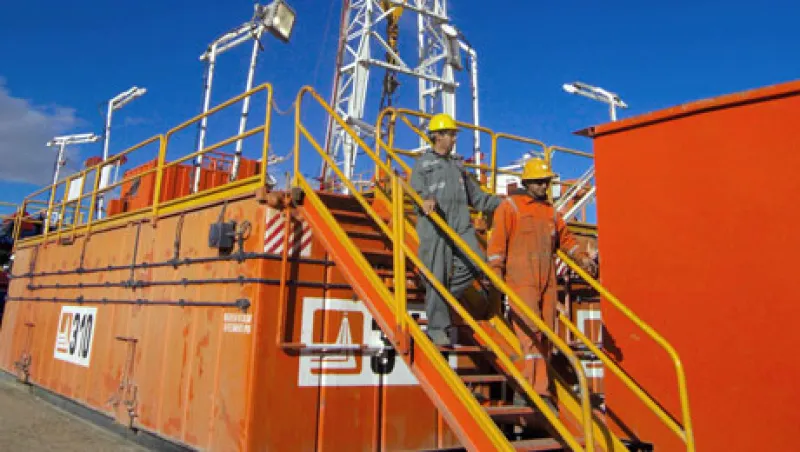For once, Argentina seems to be following a conventional script to resolve a dispute with a foreign investor. The Peronist government of President Cristina Fernández de Kirchner has reached a tentative agrement to pay $5 billion to Spanish energy firm Repsol for expropriating its 51 percent stake in YPF, the Argentinean oil and gas company (see “Argentina Oil Shale Caught in Politics, Litigation”). That seizure, in April 2012, came shortly after Repsol had announced the discovery of one of the world’s largest shale gas and oil deposits, at Vaca Muerta in western Patagonia.
But as usual with Argentina, the fine print bears close inspection. The proposed deal between the governments of Argentina and Spain and representatives of YPF and Repsol was hammered out in Buenos Aires on November 26 and approved by Repsol’s board of directors two days later. But the settlement still requires a final agreement on how the money will be paid. That could be a big hurdle, given Argentina’s turbulent record with investors.
Under the terms of the tentative accord, Argentina will pay $5 billion in ten-year sovereign bonds, denominated in dollars rather than fast-melting pesos. But the precise details — what interest rate the bonds will carry, and what guarantees there will be — remain to be determined. Argentina’s existing ten-year dollar bonds trade at a yield of about 11 percent, which is almost certainly higher than the government is willing to pay. Spanish press reports have cited talk of a coupon in the range of 8 percent to 9 percent. In addition, analysts say Repsol is insisting that the bonds carry more than the full faith and credit of the Argentinean government. “Clearly, Repsol would need guarantees that these bonds will be traded at market value to make the deal work,” says Iain Pyle, an oil analyst at Sanford C. Bernstein in London.
For Repsol, the deal promises to deliver less than half the $10.5 billion it had sought from Argentina. That figure was based on the valuation formula used by the Argentinean government when it sold YPF to Repsol in 1999. Why is the company prepared to accept less? Because of pressure from two of its largest shareholders: CaixaBank, the big Barcelona-based bank with a 12.02 percent stake, and Petróleos Mexicanos, or Pemex, which holds 9.34 percent.
For Pemex and CaixaBank, payment in liquid assets is a case of choosing the bird in the hand. Argentina is notoriously tightfisted when it comes to repaying investors. It defaulted on a record $95 billion of foreign debt in 2001, and it is continuing to fight off lawsuits from holdout bondholders, having taken its appeals to the U.S. Supreme Court earlier this year.
Nonetheless, tensions are evident between Repsol chairman and CEO Antonio Brufau Niubó, who wanted more compensation from Argentina, and the company’s big shareholders. Pemex chief executive Emilio Lozoya Austin and CaixaBank chairman Isidro Fainé Casas both showed up for negotiations in Buenos Aires with YPF CEO Miguel Galuccio and Argentinean economy minister Axel Kicillof. Brufau stayed in Madrid and had three of his executives accompany Spain’s minister of industry, energy and tourism, José Manuel Soria, to Argentina.
The expropriation of YPF clearly lit a fire under Repsol. The company has been performing well lately, and the big shareholders don’t want it to lose focus. Repsol plans to raise production from the current 344,000 barrels of oil equivalent a day to 500,000 barrels by the end of 2016, thanks to new projects in Brazil and the Gulf of Mexico. Those finds have raised Repsol’s reserve replacement ratio from just 35 percent in 2007 to 120 percent this year – one of the best levels in the industry.
To help bring the new reserves onstream, Repsol has beefed up financially by selling its liquefied natural gas business to Royal Dutch Shell in February for $4.4 billion in cash. As part of the deal, Shell also agreed to assume $2.3 billion in leases and debt.
Argentina, meanwhile, has reasons of its own to embrace the deal with Repsol, even though it would have preferred a noncash settlement, such as offering an unexplored concession in Vaca Muerta to the Spanish company.
The Fernández government’s most immediate consideration was a legal one. Repsol has several lawsuits pending over the YPF seizure that threaten to impede Argentina’s ability to develop its energy resources. The Spanish company has sued Chevron in Spain and the U.S. for its Vaca Muerta joint venture with YPF. Repsol has also petitioned the World Bank’s arbitration body to stop YPF from developing Vaca Muerta.
Argentina needs to end those legal disputes if it hopes to encourage other foreign investment to help develop its shale resources. “They want the Western oil majors to feel that Argentina is a safe place to do business and invest in projects like Vaca Muerta,” says Pyle. “I don’t think this deal will change people’s basic perception of Argentina. But it at least removes an immediate legal threat.”
In announcing the November 26 accord, Argentina’s Kicillof emphasized that “both parties will desist from legal action currently under way.”
In the longer term, Argentina has to ensure it can meet growing domestic energy demands and reduce costly fuel imports. A gas exporter to its neighbors as recently as 2006, Argentina is expected to spend $8 billion for imported oil and gas this year.
Vaca Muerta holds out the promise of transforming Argentina into a major energy player. The field has the second-largest shale gas and fourth-largest shale oil reserves in the world, according to estimates by the U.S. Energy Information Administration.
Thus far, the only significant project in the region is a $1.24 billion joint venture between YPF and Chevron to drill 120 wells. Industry experts say it will take another decade and an additional $65 billion to raise production in Vaca Muerta to the levels of Eagle Ford, the southern Texas shale formation to which the Argentinean find is most often compared. “Given Argentina’s track record, it is hard at this stage to imagine attracting such high investment,” says Laura Atkins, director of upstream petroleum research at Hart Energy, a Houston-based research company.
Fernández has other reasons to settle, too. With annual inflation running close to 25 percent — more than twice the official figure, which the International Monetary Fund rejected as inaccurate in an unprecedented censure motion earlier this year — Fernández’s candidates were routed in congressional primaries in August, dashing any hopes she had for amending the constitution to allow her to run for a third presidential term in 2015. She is viewed not only as a lame duck but also an ailing one, after a month spent recovering from brain surgery in October to stop bleeding from an unspecified head injury.
Now even her bitterest political opponents are conceding that Fernández and her cabinet deserve credit for a deal that encourages at least some foreign investment in the energy sector. “They have achieved an opening by repairing the disaster they caused with YPF,” Mauricio Macri, mayor of Buenos Aires and probable presidential candidate for the opposition in the next elections, told the popular radio station Tierra de Locos (Land of the Insane).
But many experts say it will take a saner investment climate — including a lifting of domestic price controls on oil and gas and of import barriers on drilling equipment — to raise the country’s energy prospects. “Most oil and gas companies and financial institutions will wait and see what happens with the next government’s economic and energy policies before deciding how much money to lend or invest in Argentina,” predicts Daniel Montamat, ex-president (1987–’89) of YPF and a former energy secretary who now heads own energy consulting firm in Buenos Aires.
Read more: “Latin America at Forefront of Oil Shale Shake-up”






